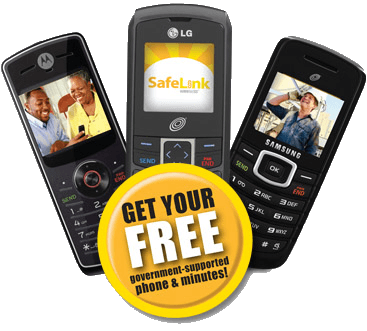Washington Footing Cell Phone Bill for Millions of Low Income Americans - $1.6 billion to cover 12.5 million phones -

Last year, a federal program paid out $1.6 billion to cover free cell phones and the monthly bills of 12.5 million wireless accounts. The program, overseen by the FCC and intended to help low-income Americans, is popular for obvious reasons, with participation rising steeply since 2008, when the government paid $772 million for phones and monthly bills. But observers complain that the program suffers from poor oversight, in which phones go to people who don't qualify, and hundreds of thousands of those who do qualify have more than one phone.
Last summer, a Pittsburgh Tribune-Review story shed some light on a government program that relatively few Americans knew existed. (Read more about it here.) The Lifeline program provides low-income Americans with free cell phones (basic ones such as those made by Tracfone, not smartphones) and covers up to 250 free minutes each month. As many as 5.5 million residents in Pennsylvania alone could qualify for the program, which is funded primarily by the Universal Service Fund fee added to the bills of land-line and wireless customers.
The program came to be after the Telecommunications Act of 1996 was passed, and the FCC created the Universal Service Fund to help "to promote the availability of quality services at just, reasonable, and affordable rates," among other things. All telecommunications carriers must pay into the fund, and many do so by tacking on a fee to each of their customers' bills. It's probably added into your monthly wireless bill and your landline bill, if you still have one.
The Universal Service Fund provides discounts on phone services, or in some cases, entirely free services to low-income Americans. The fund helps pay for landlines or cell phones, whichever the recipient prefers. There's also a one-time discount of up to $30 to cover an installation fee or a cell phone. Considering how cheap some cell phones are nowadays, the money more than covers the costs of a basic phone. Then, the fund covers phone bills to the tune of $10 a month, which typically translates as 250 minutes for wireless plans of the types of phones we're talking about. Americans who receive food stamps, Medicaid, or other federal aid, or who earn up to 135% of the federal poverty guidelines, qualify for the program.
Read more -
http://news.yahoo.com/washington-footing-cell-phone-bill-millions-low-income-202500656.html

Last year, a federal program paid out $1.6 billion to cover free cell phones and the monthly bills of 12.5 million wireless accounts. The program, overseen by the FCC and intended to help low-income Americans, is popular for obvious reasons, with participation rising steeply since 2008, when the government paid $772 million for phones and monthly bills. But observers complain that the program suffers from poor oversight, in which phones go to people who don't qualify, and hundreds of thousands of those who do qualify have more than one phone.
Last summer, a Pittsburgh Tribune-Review story shed some light on a government program that relatively few Americans knew existed. (Read more about it here.) The Lifeline program provides low-income Americans with free cell phones (basic ones such as those made by Tracfone, not smartphones) and covers up to 250 free minutes each month. As many as 5.5 million residents in Pennsylvania alone could qualify for the program, which is funded primarily by the Universal Service Fund fee added to the bills of land-line and wireless customers.
The program came to be after the Telecommunications Act of 1996 was passed, and the FCC created the Universal Service Fund to help "to promote the availability of quality services at just, reasonable, and affordable rates," among other things. All telecommunications carriers must pay into the fund, and many do so by tacking on a fee to each of their customers' bills. It's probably added into your monthly wireless bill and your landline bill, if you still have one.
The Universal Service Fund provides discounts on phone services, or in some cases, entirely free services to low-income Americans. The fund helps pay for landlines or cell phones, whichever the recipient prefers. There's also a one-time discount of up to $30 to cover an installation fee or a cell phone. Considering how cheap some cell phones are nowadays, the money more than covers the costs of a basic phone. Then, the fund covers phone bills to the tune of $10 a month, which typically translates as 250 minutes for wireless plans of the types of phones we're talking about. Americans who receive food stamps, Medicaid, or other federal aid, or who earn up to 135% of the federal poverty guidelines, qualify for the program.
Read more -
http://news.yahoo.com/washington-footing-cell-phone-bill-millions-low-income-202500656.html

No comments:
Post a Comment